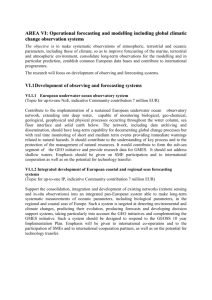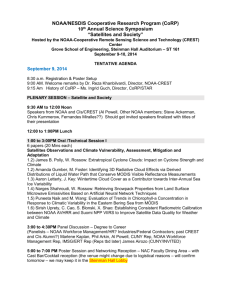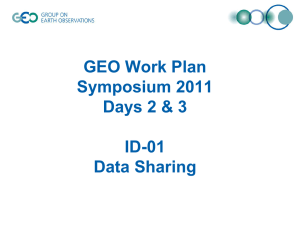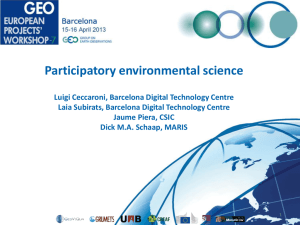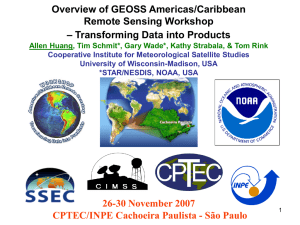The USA’s Data Challenges for the Earth Observation System of Systems
advertisement
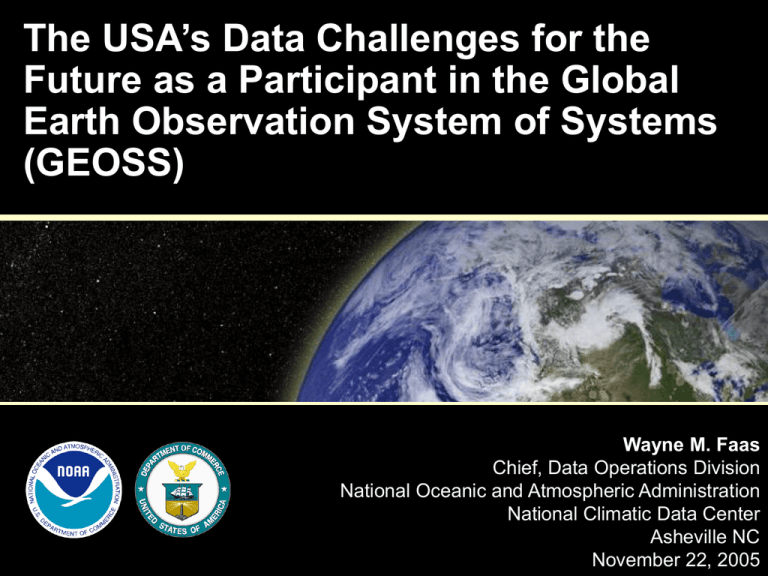
The USA’s Data Challenges for the Future as a Participant in the Global Earth Observation System of Systems (GEOSS) Wayne M. Faas Chief, Data Operations Division National Oceanic and Atmospheric Administration National Climatic Data Center Asheville NC November 22, 2005 Presentation Outline The Global Earth Observation System of Systems (GEOSS) Overview Policy Perspectives Technical Perspectives Integrated Earth Observing System National Oceanic and Atmospheric Administration (NOAA) Data Challenges 2 Space The Backbone of GEOSS 3 GEOSS Vision Enable a healthy public, economy, and planet through an integrated, comprehensive, and sustained Earth observation system From a Regional View To a Global Analysis 4 Why GEOSS? Societal issues often require: Data from a variety of observing systems Analysis of the data Research Modeling Decision support tools International Collaboration and coordination GEOSS-Global System To Meet Societal Needs Interdisciplinary focus A coordinated international system using remote sensing & in situ systems Foundation for sound decision-making: global, regional, & local level 5 Examples of Social, Economic & Science Issues Addressed by GEOSS More than 50% of the world’s population lives within 60 km of the shoreline, and this could rise to 75% by the year 2020 More than 90% of natural disaster-related deaths occur in developing countries 25% of Earth’s biological productivity & an estimated 80-90% of global commercial fish catch is concentrated in coastal zones Worldwide agricultural benefits of better El Niño forecasts are conservatively estimated at $450$550M/year 6 The Global Framework A distributed system of systems Improves coordination of strategies and observation systems Links all platforms: in situ, aircraft, and satellite networks Identifies gaps in our global capacity Facilitates exchange of data and information Improves decision-makers’ abilities to address pressing policy issues 7 What is GEOSS? Technical Perspective An end-to-end system of existing systems (both in situ and remote sensing observation platforms) linked with new systems 8 What is GEOSS? Policy Perspective GEOSS is a distributed system of systems built on current international cooperation efforts among existing Earth observing and processing systems GEOSS is Comprehensive—observations and products from all components Coordinated—leverages contributing members resources Sustained—by will and capacity of all members GEOSS enables the collection and distribution of accurate, reliable Earth Observation data, information, products, and services to both suppliers and consumers worldwide—through an end-to-end process 9 From Observations to Benefits 10 Presentation Outline The Global Earth Observation System of Systems (GEOSS) Overview Policy Perspectives Technical Perspectives Integrated Earth Observing System NOAA Data Challenges 11 Policy Challenges Harnessing the political will of nearly 60 countries Incorporating over 40 international organizations such as IOC, WMO, ISDR and UNEP These organizations – even different U.N. agencies - don’t always talk to each other GEO offers a mechanism for coordination 12 GEOSS Overview EOS I EOS I July 31, 2003, Washington, D.C. 34 Countries + 20 International Organizations EOS II April 25, 2004, Tokyo, Japan 43 Countries + EC + 26 International Organizations EOS II EOS III February 2005, Brussels 60 Countries + EC + 34 International Organizations 10-Year Implementation Plan Commerce Secretary Gutierrez led the US delegation EOS III 13 GEO I Geneva, Switzerland First meeting GEO agreed to 12 member Executive Committee Africa (2), Americas (3), Asia and Oceania (3), Commonwealth of Independent States (1), Europe (3) Co-Chairs: US, EC (developed); China, South Africa (developing) Tsunami Update – IOC 14 3 1 3 2 3 Americas Brazil Honduras USA Europe European Commission Italy Germany GEO Executive Committee Africa South Africa Morocco Asia/Oceania China Japan Thailand Commonwealth of Independent States Russia 15 GEO Exec Com Initial Meeting Immediately after GEO I (June, Geneva) Establish Functions and Roles Exec Com = Working Body / GEO = Decision Body Set Up Committee Structure S&T Mechanism User Interface Mechanism Architecture Data Policy 16 Public Engagement is a Priority Public Engagement Workshop—Continuing the Dialogue Washington, DC, May 9-10 +400 attendees from all sectors Discussion of Societal Benefit Areas Discussion of Near Term Opportunities Integration Frameworks Data Management Improved Observations for Disaster Warnings Global Land Observing System Sea Level Observing System National Integrated Drought Information System Air Quality Assessment and Forecast System 17 Presentation Outline The Global Earth Observation System of Systems (GEOSS) Overview Policy Perspectives Technical Perspectives Integrated Earth Observing System NOAA Data Challenges 18 Technical Advancements… Geostationary Satellites Much improved spatial and temporal coverage Current GOES Sounder coverage in one hour GOES-R: New generation of current U.S. geostationary operational environmental satellite (GOES) series GOES-R HES Sounder coverage in one hour CIMSS 19 Technical Advancements… Polar Satellites NPOESS: National Polar-Orbiting Operational Environmental Satellite System Advanced imager offers near-constant resolution across scan Additionally, VIIRS brings a great increase in multispectral channels OLS AVHRR VIIRS 2 6 22 20 … Bring Technical Challenges Data Management Needs New Systems mean 100fold increase in data Current systems already face challenges Development of browser and visualization systems— underpinned by core geospatial technologies Interoperability through protocols and standards 21 Architecture Needs Support for a range of implementation options Addressing planned, research and operational systems Interfaced capabilities through interoperability specifications Inclusion of metadata and quality indicators Continuity of observations, and instigation of new observations Building on existing systems and historical data In U.S., focus on Federal Enterprise Architecture Framework 22 Architecture Targets: GEO Within two years, GEOSS will: Advocate formal commitments of contributions by GEO Members and Participating Organizations Produce a publicly accessible, network-distributed catalogue Establish and maintain a process for reaching interoperability arrangements Advocate use of existing Spatial Data Infrastructure (SDI) components as institutional and technical precedents Develop a cost-and-benefit-sharing mechanism(s) for observations 23 Presentation Outline The Global Earth Observation System of Systems (GEOSS) Overview Policy Perspectives Technical Perspectives Integrated Earth Observing System NOAA Data Challenges 24 U.S. Contribution to GEOSS An Interagency Effort 25 Global Earth Observing Integrated Data Environment (GEO-IDE) • Scope: NOAA-wide architecture development to guide all NOAA observation data management systems • Result: A single system of systems (user perspective), that allows access to data sets needed to address societal questions • GEO IDE Current Status • Planning has begun now in order to address US IEOS and GEOSS critical societal needs • Cross NOAA Goal planning team formed • Draft data management plan complete FY05 • Final plan released to be in FY06 26 Global Earth Observing System of Systems Discipline Specific View Whole System View Atmospheric Observations Land Surface Observation Ocean Observations Space Observations Data Systems 27 Current systems are program specific, focused, individually efficient. But incompatible, not integrated, isolated from one another and from wider environmental community Coordinated, efficient, integrated, interoperable 27 Architecture — National Builds on existing systems Addresses planned, research and operational systems Capabilities interfaced through interoperability specifications Preserves continuity of observations 28 Integrated Data Environment Bridging the gaps between stove-pipe systems • Integration of data across disciplines • Improved data stewardship • Increased efficiency • Leverage industry and community initiatives Standard procedures, protocols, metadata, formats, terminology. Translators and middleware Weather 29 Climate Hydrology Oceanography Biology Geophysics 29 Products “Success requires the interaction, cooperation, and feedback that comes only if all parties work together” Users VADM Lautenbacher NOAA’s Strategic Plan Observations Benefits 30 Overview Architecture and Data Management IEOS Near Term Opportunity (NTO) Starting with NTOs and expanding to all IEOS data management systems, the following gaps will be addressed: Federal Agency coordination of strategies and observation systems Not a single system; rather Interoperability among existing data management systems Data linkages for All platforms: in situ, aircraft, satellite Innovative approaches to information and knowledge management across agencies Implemented standards/protocols for data and metadata Improved decision-makers’ abilities to address policy and societal benefit issues 31 Presentation Outline The Global Earth Observation System of Systems (GEOSS) Overview Policy Perspectives Technical Perspectives Integrated Earth Observing System NOAA Data Challenges 32 NOAA’s Satellites and Information Service: Mission NOAA’s Mission For the protection and enhancement of the Nation’s economy, security, environment, and quality of life... • NOAA’s Satellites and Information Service: – Provides and ensures timely access to global environmental data, and – Provides information services including earth system observation, monitoring and environmental assessments • To fulfill its responsibilities, NOAA’s Satellites and Information Service acquires and manages the Nation’s civil operational environmental satellites and operates the NOAA National Data Centers 33 33 NOAA’s Satellite and Information Services: NOAA’s Satellite and Information Programs Services:Major Major Programs • Geostationary Operational Environmental Satellite (GOES) • Polar-orbiting Operational Environmental Satellite (POES) • National Polar-orbiting Operational Environmental Satellite System (NPOESS) • Environmental Satellite Observing Services • NOAA’s Data Centers & Information Services 34 Fire Detection Satellite Winds Severe Weather NOAA Satellite Products Aerosols Volcanic Ash Monitoring Sea Surface Temp 35 35 NOAA’s Data Products Multibeam data 36 36 Planned Satellite Data Volumes Integrated Joint Polar Program/Metop 35 GB/Day – 12.3 TB/Year December 2005 NPP/NPOESS 4 TB/Day – 1.5 PB/Year/Satellite December 2006 Operational 2 Spacecraft Constellation in 2010 GOES R-series 3 TB/Day – 1.1 PB/Year/Satellite 2012 Operational 2 Spacecraft Constellation in 2014 NASA EOS 4 TB/Day 37 Comprehensive Large-Array Data Stewardship System (CLASS) CLASS is NOAA’s long-term, permanent, on-line data archive for all of NOAA’s environmental data. Target data holdings by 2015 is 80 Petabytes; 160 Petabytes with the replication/backup Total existing data volume from NOAA and NASA environmental assets destined for archive in CLASS is about …. 20 Petabytes 60 Petabytes projected by 2012 38 Planned Model Data Volumes Over the next ten years access to real-time and archived models are required for climate projections, reducing uncertainty in those projections, impacts assessments and downscaling issues. These data include: Numerical Weather Prediction (NWP), NWP Reanalysis Ensembles (probability predictions) National Digital Forecast Database (NDFD) Regional and Global Climate models 2005-2010: 1000 Terabyte 2010-2017: + 4000 Terabyte 39 Planned Radar Data Volumes Increased radar data volumes to approximately 2 petabytes per year by 2010 Improved capabilities Faster volume coverage pattern and more scans per volume coverage pattern Increased resolution from 1.0 km reflectivity data to 0.25 km reflectivity data Increased azimuthal sampling from 1.0 degree to .5 degree Implementation of dual polarization Benefits Faster and better detection of severe weather Improved precipitation amount estimation Improved estimation of rain and snow rates Identification of precipitation type in winter storms Identification of electrically active storms Identification of aircraft icing conditions 40 Future Archive Data Volumes 41 GEOSS, IEOS, AND NOAA SUMMARY Improved observation collection and use for model enhancements Improved forecast and warning services worldwide Improved understanding of oceans and atmosphere Improved societal benefits worldwide 42 Questions? 43
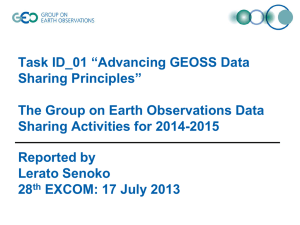

![Eduardo A. Araujo-Pradere [], CIRES, University of Colorado, Solar Minimum](http://s2.studylib.net/store/data/013086460_1-158f16f4991b8d654a2183bbdcda9c6c-300x300.png)
